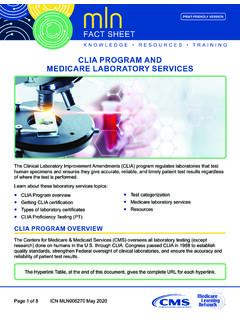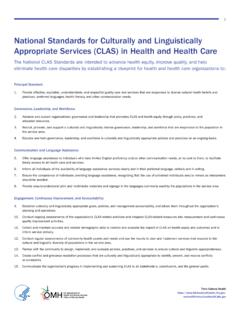Transcription of HIV Prevention in the United States:Mobilizing to End the ...
1 HIV Prevention in the United States:Mobilizing to End the Epidemic INTRODUCTIONT oday, we have an unprecedented opportunity to end America s HIV Prevention and treatment have brought the annual number of new HIV infections to an all-time low since the start of the People with HIV can live long, healthy lives thanks to improved antiretroviral therapy. Powerful Prevention tools including simple and effective HIV treatment and pre-exposure prophylaxis (PrEP) can practically eliminate transmission if used by all who need them. Improvements in HIV surveillance mean we can identify and respond to potential outbreaks more effectively than ever. Yet progress in HIV Prevention has slowed. Many people still aren t getting the Prevention and care they need. The nation s opioid crisis poses a continual threat of new HIV outbreaks due to injection drug While the full impact of the global COVID-19 pandemic on our HIV Prevention efforts is unclear, it has thrown into sharp relief the extent to which longstanding, systemic health and social inequities among different racial/ethnic groups negatively affect health outcomes.
2 For far too long, these inequities including discrimination, stigma, income, systemic racism, and mistrust of the healthcare system have led to persistent disparities in HIV risk, Prevention , treatment, and care, particularly for Black/African American and Hispanic/Latino people. Without bold action to address these challenges today, we could see an increase in HIV in the United the nation s lead HIV Prevention agency, CDC is working with partners to achieve dramatic new declines in HIV infections. Together with other federal agencies, state and local governments, people with HIV, individuals who could benefit from biomedical and other Prevention strategies, and the organizations and leaders in their communities, CDC aims to: Infuse the hardest hit communities with resources, technology, innovation, and expertise to strengthen Prevention and care; Ensure that affected communities and people with HIV have a powerful voice in shaping Prevention programs; Confront stigma and other societal barriers to delivering HIV Prevention and care; and Monitor our collective impact and hold each other accountable for progress.
3 2 | HIV Prevention IN THE United STATES: MOBILIZING TO END THE EPIDEMIC GOALR educe new HIV infections by90% by2030 HIV Prevention IN THE United STATES: MOBILIZING TO END THE EPIDEMIC | 3 The federal initiative, Ending the HIV Epidemic (see sidebar), advances all of these approaches by bolstering CDC s long-standing partnerships with state and local health departments and affected communities. But federal initiatives alone will not be sufficient. Ending the HIV epidemic requires leadership from all corners and engagement from local communities. The disease has cost our nation too much in lives lost and dollars spent to not embrace today s opportunity. The time to act is the HIV Epidemic Initiative Launched in early 2019 by the Department of Health and Human Services (HHS), the Ending the HIV Epidemic initiative aims to reduce new HIV infections in the United States by 90 percent by the initiative, CDC and other federal agencies will provide a targeted infusion of new resources, technology and expertise to expand HIV Prevention and treatment activities.
4 For the first five years, the initiative prioritizes 50 local areas that account for more than half of new HIV diagnoses (48 counties; San Juan, Puerto Rico; and Washington, ), and seven states with a substantial rural initiative focuses on four key strategies: DIAGNOSE all people with HIV as early as people with HIV rapidly and effectively to reach sustained viral new HIV transmissions using proven interventions, including PrEP and syringe service programs (SSPs).RESPOND quickly to potential HIV outbreaks to get needed Prevention and treatment services to people who need information about the initiative is available at OF HIV IN THE HIV Prevention and care efforts have taken us from a peak of 130,000 HIV infections annually in the mid-1980s3 to approximately 36,400 in 4 | HIV Prevention IN THE United STATES: MOBILIZING TO END THE EPIDEMIC But progress in reducing new HIV infections has slowed in recent years and not everyone is benefiting equally.
5 ANNUAL HIV INFECTIONS HAVE STABILIZED, UNDERSCORING THE NEED FOR IMMEDIATE ACTION. THIS OVERALL STABILITY MASKS IMPORTANT in reducing new HIV infections has slowed in recent years, to about 38,000 new infections each year between 2014 and HIV Infections in the , 2014-2018 STATUS OF HIV IN THE ,00002014201520162017201833,00035,00037, 00039,00041,00010,000 White Heterosexual WomenLatina Heterosexual WomenAfrican American Heterosexual WomenLatino Gay and Bisexual MenAfrican American Heterosexual MenWhite Gay and Bisexual MenAfrican American Gay and Bisexual Men5,0004,0009,4007,5007,1005,700**3,600 3,5001,8001,5009901,0009009103,0002,0001 ,00006,0007,0008,0009,000 During this period, gay and bisexual men, Black/African Americans and Hispanics/Latinos bore the greatest burden of new HIV New HIV Infections by Race and Transmission Group in the , 2014 vs. 2018*8,0002014201838,00038,40038,50037,0 0036,4009,800 HIV Prevention IN THE United STATES: MOBILIZING TO END THE EPIDEMIC | 5* Subpopulations representing or less of new HIV infections in 2018 are not represented in this chart**Decline in new infections from 2014 to 2018 deemed a statistically significant decreaseHIV TREATMENT AND Prevention EFFORTS ARE NOT REACHING EVERYONE WHO NEEDS THEM.
6 Although HIV remains a threat in every part of the United States, certain populations and parts of the country bear most of the burden, signaling where HIV Prevention efforts must be focused. HIV by Population > Black and Hispanic/Latino communitiesare disproportionately affected by HIV compared to other racial/ethnic groups. Prevalence of HIV infection by race/ethnicity, 20187 STATUS OF HIV IN THE African American41% Asian Multiple Races American Indian/ Alaska Native Native Hawaiian and Other Pacific Islander White29%Hispanic/ Latino23%Male-to-male sexual contact67%Heterosexual drug sexual contact and injection drug use Multiple Races 2% African American13% Asian 6% American Indian/ Alaska Native Native Hawaiian and Other Pacific Islander White60%Hispanic/ Latino18%Race/ethnicity of the population, 201886 | HIV Prevention IN THE United STATES: MOBILIZING TO END THE EPIDEMIC > In all regions of the , gay and bisexual men are the group most affected by HIV.
7 They account for about 70 percent of new HIV infections each year,9 even though they make up only 2 percent of the population,10 with the highest burden among Black and Hispanic/Latino gay and bisexual men and young men. In 2018, 26 percent of new HIV infections were among Black gay and bisexual men; 22 percent among Hispanic/Latino gay and bisexual men; and 46 percent among gay and bisexual men under the age of HIV Infections in the , 20189> By age group, people ages 25-34 have the highest rate of annual HIV 2018, they accounted for 40 percent of new HIV infections, primarily reflecting the higher number of infections among gay and bisexual men in this age group. Youth with HIV (people ages 13-24) account for 21 percent of new HIV infections each year and are the least likely of any age group to have a suppressed viral ,13 People ages 25-34 account for40%of new HIV infections each HIV Infections in the , 20189> Among women, disparities persist.
8 Black women are disproportionately affected by HIV compared to women of other races/ethnicities. Although annual HIV infections remained stable among Black women from 2014-2018, the rate of new HIV infections among Black women is 13 times that of White women and 4 times that of Hispanic/Latina Transgender women are also heavily affected by HIV. Available evidence suggests that in relation to their population size, transgender women are among the groups most affected by HIV in the : estimated HIV prevalence for transgender women is 14 percent15 a striking difference when compared to HIV prevalence estimates for adults in the overall (< ).16,17 CountiesStates with substantial rural burden STATUS OF HIV IN THE The rate of new HIV infections among Black women is 13xthat of White women.> In 2018, 7 percent of new HIV infections in the * were among people who inject drugs (PWID).
9 **Long-term declining trends in HIV incidence among PWID have stalled, and new infections have begun to increase in some demographic groups and geographies. For example, in 2018 compared with 2014, the number of HIV infections attributed to injection drug use increased 97 percent for White Localized outbreaks have contributed to these 2014 to 2018, HIV infections increased 97%among White men who inject drugs. HIV Prevention IN THE United STATES: MOBILIZING TO END THE EPIDEMIC | 7*Does not include Puerto Rico**Excludes men who have sex with men (MSM) and inject drugsHIV by Geography Most of the nation s HIV diagnoses are concentrated in certain geographic areas, with the majority of diagnoses occurring in southern states. In 2016 and 2017, more than half of new HIV diagnoses were concentrated in geographic hotspots across the : 48 counties plus Washington, and San Juan, Puerto states also have a substantial rural burden: Alabama, Arkansas, Kentucky, Missouri, Mississippi, Oklahoma, and South 57jurisdictions are prioritized for the Ending the HIV Epidemic TRANSMISSION IS DRIVEN BY GAPS IN THE HIV CARE ensuring that everyone with HIV is aware of their status, receives the treatment they need, and achieves and maintains viral suppression key steps in the HIV care continuum we can preserve the health of people with HIV and drive down new HIV infections, which is essential because: STATUS OF HIV IN THE 1 in 7 One in seven people with HIV (14%*) still don't know they have it, meaning they are not receiving the care they need to stay healthy and prevent transmission to others.
10 35%One in three people with HIV (35%*) are not receiving needed HIV care. 80 percent of new HIV infections are transmitted by people who are not aware they have HIV or not receiving any HIV percent* of people in HIV care have not reached viral suppression through *Based on 2018 data8 | HIV Prevention IN THE United STATES: MOBILIZING TO END THE EPIDEMIC The proportion of people with undiagnosed HIV is high in some parts of the country, especially in the South, likely contributing to the high burden of HIV in the of People with Undiagnosed HIV by State, 201822100806040200 DIAGNOSEDRECEIPT OF CARERETAINED IN CAREVIRAL SUPPRESSION86%65%50%56%STATUS OF HIV IN THE help gauge progress and direct HIV Prevention resources most effectively, CDC tracks the HIV care continuum a series of steps from the time a person receives an HIV diagnosis through successful treatment with HIV medications.















